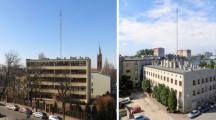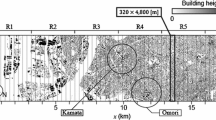Abstract
Data from low-level soundings over Cambridge, U.S.A. were selected on the basis of an Ekman-like variation of the wind vector with altitude combined with evidence of a barotropic atmosphere. The method of geostrophic departure was used to determine the shear-stress distribution. The analysis yields the dimensionless properties of the barotropic Ekman layer under neutral and stable stratification. Some important results include: the geostrophic drag coefficient displays no dependence on the degree of static stability; the dimensionless height of the boundary layer decreases with increasing stability in agreement with the prediction of Zilitinkevich; the properties of the urban surface layer, where the roughness elements are multistory buildings, show no dependence on atmospheric stability under the moderate wind conditions which display the Ekman-like wind profile; and the directions of the horizontal shear stress and the vertical derivative of the velocity vector usually tend to be parallel only near the surface layer. Values of the two constants of the Rossby number similarity theory are found for the neutral barotropic Ekman layer at a surface Rossby number equal to 2 × 105. The implications of the work with respect to wind-tunnel simulation of the flow over models of urban areas are discussed.
Similar content being viewed by others

References
Antonia, R. A., and Luxton, R. E.: 1971, The Response of a Turbulent Boundary Layer to a Step Change in Surface Roughness, Part 1. Smooth to Rough, J. Fluid Mech. 48, 721–761.
Blackadar, A. K.: 1962, The Vertical Distribution of Wind and Turbulent Exchange in a Neutral Atmosphere, J. Geophys. Res. 67, 3095–3102.
Blackadar, A. K. and Tennekes, H.: 1968, Asymptotic Similarity in Neutral Barotropic Planetary Boundary Layers, J. Atmos. Sci. 25, 1015–1020.
Businger, J. A., Wyngaard, J. C., Izumi, Y., and Bradley, E. F.: 1971, Flux-Profile Relationships in the Atmospheric Surface Layer, J. Atmos. Sci. 28, 181–189.
Clarke, R. H. and Hess, G. D.: 1974, Geostrophic Departure and the Functions A and B of Rossby-Number Similarity Theory, Boundary-Layer Meteorol. 7, 267–287.
Counihan, J.: 1971, Wind Tunnel Determination of the Roughness Length as a Function of the Fetch and the Roughness Density of Three-Dimensional Roughness Elements, Atmos. Environ. 5, 637–642.
Csanady, G. T.: 1967, On the Resistance Law of a Turbulent Ekman Layer, J. Atmos. Sci. 24, 467–471.
Deacon, E. L.: 1973, Geostrophic Drag Coefficients, Boundary-Layer Meteorol. 5, 321–340.
DeMarrais, G. A.: 1959, Wind-Speed Profile at Brookhaven National Laboratory, J. Meteorol. 16, 181–190.
Fiedler, F.: 1972, The Effect of Baroclinicity on the Resistance Law in a Diabatic Ekman Layer, Beitr. Phys. Atmos. 45, 164–173.
Gill, A. E.: 1968, Similarity Theory and Geostrophic Adjustment, Quart. J. Roy. Meteorol. Soc. 94, 586–588.
Gill, A. E.: 1969, The Turbulent Ekman Layer, Dept. of Applied Mechanics and Theoretical Physics, University of Cambridge.
Hess, G. D.: 1974, Reply to Yordanov (1974), J. Atmos. Sci. 31, 1939.
Houlton, J. R.: 1972, An Introduction to Dynamic Meteorology, Academic Press.
Kazanski, A. B. and Monin, A. S.: 1961, On the Dynamic Interaction Between the Atmosphere and the Earth's Surface, Izv. Akad. Nauk., S.S.S.R., Geophys. Ser. No. 5, 786–788.
Kirschner, B. H.: 1971, ‘Environmental Meteorological Support Unit: A New Weather Bureau Program Supporting Urban Air Quality Control’, Proceedings of the Second International Clean Air Congress, (H. M. England and W. T. Beery, Eds.) Academic Press.
Lettau, H. H.: 1950, A Re-examination of the ‘Leipzig Wind Profile’ Considering Some Relations Between Wind and Turbulence in the Frictional Layer, Tellus 2, 125–129.
Lettau, H. H.: 1970, Physical and Meteorological Basis for Mathematical Models of Urban Diffusion Processes, Proceedings of Symposium on Multiple-Source Urban Diffusion Models, (A. C. Stern, ed.) U.S. Government Directory Office, Washington, D.C.
Mildner, P.: 1932, über die Reibung in einer speziellen Luftmasse in den untersten Schichten der Atmosphäre, Beitr. Phys. Atmosph. 19, 151–158.
Sadeh, W. Z., Cermak, J. E., and Kawatani, T.: 1971, Flow Over High Roughness Elements, Boundary-Layer Meteorol. 1, 321–344.
Seinfeld, J. H.: 1975, Air Pollution: Physical and Chemical Fundamentals, McGraw-Hill.
Tennekes, H.: 1973, The Logarithmic Wind Profile, J. Atmos. Sci. 30, 234–238.
Yordanov, D.: 1974, Comments on ‘Rossby-Number Similarity Theory for a Baroclinic Planetary Boundary Layer, J. Atmos. Sci. 31, 1938.
Zilitinkevich, S. S.: 1972, On the Determination of the Height of the Ekman Boundary Layer, Boundary-Layer Meteorol. 3, 141–145.
Author information
Authors and Affiliations
Rights and permissions
About this article
Cite this article
Dobbins, R.A. Observations of the barotropic Ekman layer over an urban terrain. Boundary-Layer Meteorol 11, 39–54 (1977). https://doi.org/10.1007/BF00221823
Revised:
Issue Date:
DOI: https://doi.org/10.1007/BF00221823



